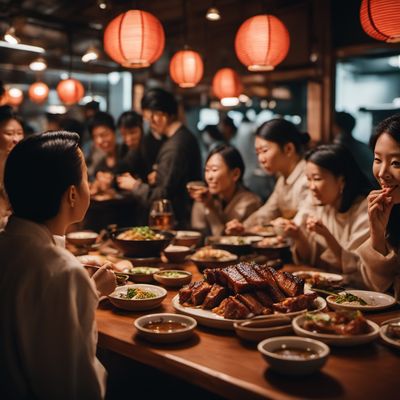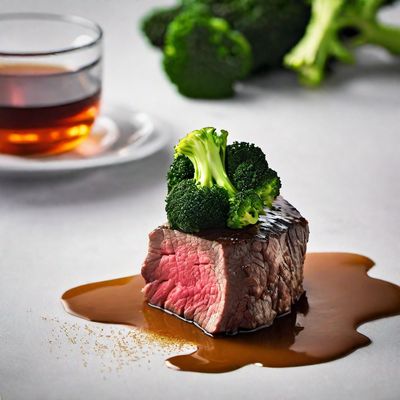
Recipe
Molecular Gastronomy Ramen
Ramen Reimagined: A Molecular Gastronomy Twist
4.8 out of 5
Molecular gastronomy is a cuisine that focuses on the scientific aspects of cooking. It involves using innovative techniques and ingredients to create unique and unexpected flavors and textures. This recipe takes the traditional Japanese ramen and gives it a molecular gastronomy twist, resulting in a dish that is both visually stunning and deliciously complex.
Metadata
Preparation time
720 minutes (12 hours for sous-vide pork belly)
Cooking time
45 minutes
Total time
765 minutes
Yields
4 servings
Preparation difficulty
Medium
Suitable for
Pescatarian, Dairy-free, Gluten-free, Low-carb, Low-fat
Allergens
Soy, Sesame, Eggs
Not suitable for
Vegetarian, Vegan, Paleo, Keto, High-fat
Ingredients
This recipe differs from traditional ramen in that it uses molecular gastronomy techniques to create a unique flavor and texture profile. The broth is made using a sous-vide technique to extract maximum flavor from the ingredients, and the noodles are made using a spherification process that results in a burst of flavor with each bite. We alse have the original recipe for Ramen, so you can check it out.
-
1 lb (450g) pork belly 1 lb (450g) pork belly
-
4 cups (950ml) chicken stock 4 cups (950ml) chicken stock
-
1 cup (240ml) soy sauce 1 cup (240ml) soy sauce
-
1 cup (240ml) mirin 1 cup (240ml) mirin
-
1 cup (240ml) sake 1 cup (240ml) sake
-
1 tbsp (15ml) sesame oil 1 tbsp (15ml) sesame oil
-
1 tbsp (15ml) miso paste 1 tbsp (15ml) miso paste
-
1 tbsp (15ml) ginger, grated 1 tbsp (15ml) ginger, grated
-
1 tbsp (15ml) garlic, minced 1 tbsp (15ml) garlic, minced
-
1 tbsp (15ml) brown sugar 1 tbsp (15ml) brown sugar
-
1 tsp (5ml) black pepper 1 tsp (5ml) black pepper
-
1 tsp (5ml) chili flakes 1 tsp (5ml) chili flakes
-
1 tsp (5ml) xanthan gum 1 tsp (5ml) xanthan gum
-
1 tsp (5ml) sodium alginate 1 tsp (5ml) sodium alginate
-
1 cup (240ml) water 1 cup (240ml) water
-
1/2 cup (120ml) calcium lactate 1/2 cup (120ml) calcium lactate
-
1/4 cup (60ml) green onions, thinly sliced 1/4 cup (60ml) green onions, thinly sliced
-
1/4 cup (60ml) cilantro, chopped 1/4 cup (60ml) cilantro, chopped
-
1/4 cup (60ml) bean sprouts 1/4 cup (60ml) bean sprouts
-
1/4 cup (60ml) bamboo shoots 1/4 cup (60ml) bamboo shoots
-
1/4 cup (60ml) shiitake mushrooms, sliced 1/4 cup (60ml) shiitake mushrooms, sliced
-
4 eggs, soft-boiled 4 eggs, soft-boiled
-
1 tbsp (15ml) sesame seeds 1 tbsp (15ml) sesame seeds
Nutrition
- Calories: 550 kcal / 2300 KJ
- Fat: 25g (8g saturated)
- Carbohydrates: 35g (10g sugars)
- Protein: 45g
- Fiber: 3g
- Salt: 4g
Preparation
-
1.Preheat sous-vide machine to 165F (74C).
-
2.Season pork belly with salt and pepper and vacuum-seal in a sous-vide bag. Cook for 12 hours.
-
3.In a large pot, combine chicken stock, soy sauce, mirin, sake, sesame oil, miso paste, ginger, garlic, brown sugar, black pepper, and chili flakes. Bring to a boil and simmer for 30 minutes.
-
4.Strain the broth and add xanthan gum. Use an immersion blender to blend until smooth.
-
5.In a bowl, mix sodium alginate and water until dissolved. In another bowl, mix calcium lactate and water until dissolved.
-
6.Using a dropper, drop the broth mixture into the sodium alginate mixture, forming small spheres. Let sit for 2-3 minutes.
-
7.Remove the spheres from the sodium alginate mixture and rinse in water.
-
8.Cook the ramen noodles according to package instructions.
-
9.In a bowl, combine the noodles, pork belly, broth spheres, green onions, cilantro, bean sprouts, bamboo shoots, shiitake mushrooms, and soft-boiled eggs.
-
10.Sprinkle with sesame seeds and serve immediately.
Treat your ingredients with care...
- Pork belly — For best results, use a high-quality pork belly with a good fat-to-meat ratio.
- Sodium alginate — Make sure to dissolve the sodium alginate completely in the water to avoid clumping.
- Calcium lactate — Make sure to dissolve the calcium lactate completely in the water to avoid clumping.
Tips & Tricks
- For a vegetarian version, substitute the pork belly with tofu or mushrooms.
- For a spicier broth, increase the amount of chili flakes.
- For a creamier broth, add a splash of heavy cream.
- For a more umami flavor, add a dash of fish sauce.
- For a more authentic ramen experience, serve with chopsticks and a spoon.
Serving advice
Serve the ramen hot, garnished with sesame seeds and additional green onions and cilantro, if desired.
Presentation advice
Arrange the ingredients in the bowl in an aesthetically pleasing way, with the broth spheres scattered throughout.
More recipes...
For Ramen » Browse all
For Japanese cuisine » Browse all
More Japanese cuisine dishes » Browse all

Wafu
Wafu Dressing
Wafu is a traditional Japanese salad dressing that is known for its light and refreshing flavor. It is a versatile dressing that can be used on a...

Chashu
Braised Pork Belly
Chashu is a Japanese dish that is made with braised pork belly and served with ramen noodles. It is a rich and flavorful meal that is perfect for...

Kaiseki
Kaiseki is a traditional multi-course Japanese meal that originated in Kyoto. It is a culinary art form that emphasizes the balance of taste,...









